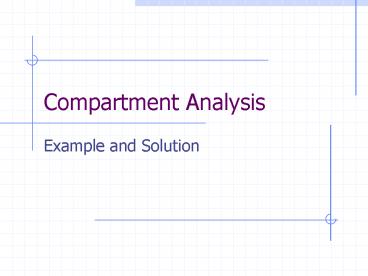Compartment Analysis - PowerPoint PPT Presentation
1 / 29
Title:
Compartment Analysis
Description:
Data estimation (study on subjects) Our case: Questions. Solution ... Measure lead concentration during the time in each compartment (study on subjects) ... – PowerPoint PPT presentation
Number of Views:23
Avg rating:3.0/5.0
Title: Compartment Analysis
1
Compartment Analysis
- Example and Solution
2
Application
Compartmental analysis of physiological system
can say about permeability of physiological
barriers to specific drugs, toxins, etc.
3
Short review
- Example of Compartment Analysis
- Problem statement
- Block diagram of Compartment Model
- The Mathematics of diffusion
- Data estimation (study on subjects)
- Our case
- Questions
- Solution
4
- Example of Compartment Analysis
- Problem statement
- Block diagram of Compartment Model
- The Mathematics of diffusion
- Data estimation (study on subjects)
- Our case
- Questions
- Solution
5
Lead in the organism
- How foreign substances get into the body
- How they become distributed
- How they effect
- How they are eliminated from the body
6
Compartment model for lead
- Divide physiological system into biological
compartments blood, bones and soft tissues. - Describe lead movement from one compartment to
another.
7
- Example of Compartment Analysis
- Problem statement
- Block diagram of Compartment Model
- The Mathematics of diffusion
- Data estimation (study on subjects)
- Our case
- Questions
- Solution
8
Block diagram
environment
blood
Soft tissue
bones
1
3
2
Compartmental model of the biological tissue
types in which lead becomes distributed.
9
(No Transcript)
10
- Example of Compartment Analysis
- Problem statement
- Block diagram of Compartment Model
- The Mathematics of diffusion
- Data estimation (study on subjects)
- Our case
- Questions
- Solution
11
Mathematics of diffusion
Many biological phenomena - random
process. Diffusion can be modeled as a random
walk. Ficks Law Diffusion transports
particles from region of high concentration to
places of low concentration.
12
(No Transcript)
13
(No Transcript)
14
- Example of Compartment Analysis
- Problem statement
- Block diagram of Compartment Model
- The Mathematics of diffusion
- Data estimation (study on subjects)
- Our case
- Questions
- Solution
15
Data estimation
- Measure lead concentration during the time in
each compartment (study on subjects). - The collected data have to follow the equations
which we derive, therefore - We approximate the data with
already known functions. - Estimation of functions parameters
16
Solutions for the equations
.0211 .0124 .000035 .0111 .0039 49.3
From a study of lead intake and excretion of a
healthy volunteer living in the area of heavy
smog Rabinowitz, Wetherill and Kopple, (1973)
17
- Example of Compartment Analysis
- Problem statement
- Block diagram of Compartment Model
- The Mathematics of diffusion
- Data estimation (study on subjects)
- Our case
- Questions
- Solution
18
Our case
We measure potential difference (standing
potential) which originates between basal and
apical surface of RPE cells.
-
-
-
Apical membrane
Basal membrane
One layer RPE cells
19
Our case
Potential difference is a sum of ions
in one side and in another side of RPE cells
reference from R.H. Steinberg, Interaction
between the retinal pigment epithelium and the
neural retina, (1985)
20
- Example of Compartment Analysis
- Problem statement
- Block diagram of Compartment Model
- The Mathematics of diffusion
- Data estimation (study on subjects)
- Our case
- Questions
- Solution
21
1. How to divide the physiological system into
compartments? Can we get the solution by
measuring only the potential difference between
compartments?
2. How to describe the directions of movements of
ions between compartments? Ions
22
In vivo
Subretinal space
Choroid
-
-
-
Apical membrane
Basal membrane
One layer RPE cells
3. There is not only passive transport of ions
diffusion, but also transport which acts against
diffusion gradient Can we use only mathematics
of diffusion as we do by using compartmental
analysis?
23
- Example of Compartment Analysis
- Problem statement
- Block diagram of Compartment Model
- The Mathematics of diffusion
- Data estimation (study on subjects)
- Our case
- Questions
- Solution
24
The solution
- To use one specific ion group i.e. potassium
- To measure concentration (potential) of
potassium ions in each compartment with
potassium-specific electrodes.
Condition There is no other forces influencing
particles except forces described by Ficks.
25
Problem statement
Distribution of potassium concentration in
subretinal space and in RPE cell using pig eye in
vitro.
26
Lets say
Compartment Model for
0
3
Choroid
Retina
RPE cell
Subretinal space
1
2
27
The Mathematics of diffusion of
The parameters of bi-exponential function
will show the permeability rate of apical
membrane for potassium in ante mortem state.
28
Data estimation
- Measure the concentration of potassium in both
compartments with potassium-specific electrodes.
(Also we have to known ) - Approximate the recorded data with derived
functions (see above). - Estimate the function parameters
- Draw the graphics potassium concentration in
subretinal space during the time, and potassium
concentration in RPE cell during the time.
29
So, what do you think?































